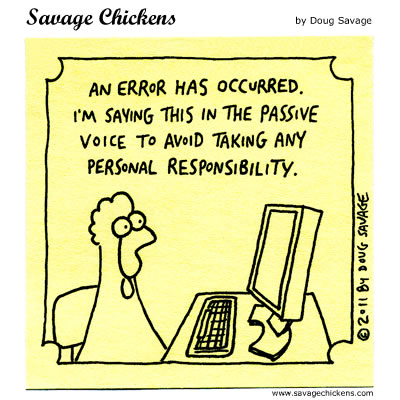Simultaneous Cringe and Laugh
Okay, I have to admit I cringed and laughed at the same time when I saw this. Once before I wrote about what you call someone who’s picky and public about correct grammar. Oops—twice, I guess. I would have included this comic (posted in The Nib) if it had been published then. It’s one of six, by the way. Go look.

At least the guy is correct about his grammar…
Subscribe to this blog's RSS feed
Geek, Curmudgeon, or Nazi?
Prefix those three words with “Grammar” and you have the topic of today’s post. You could add a few other terms to the list: expert, teacher, nuisance. But that would make for an awkward title.
What are the differences? (Yes, I know, it could be “What’s the difference?”)
Grammar Geek—likes grammar, likes to discuss the topic, likes to play with grammar and analyze differences in meaning.
Grammar Curmudgeon—complains about bad grammar in general, often stimulated when he sees instances of the same. Frequently uses the word “harrumpf,” generally more good-natured than he pretends to be. (The female version is a curmudgeonne, but I digress.)
Grammar Nazi—someone who corrects others’ grammar, often without being asked to do so. Most people consider these folks to be rude nit pickers.
Grammar Expert—any of the above if you ask them for their opinion about grammar.
Grammar Teacher—me, a century ago. Most grammar teachers are paid for their service, and have an opportunity to change people’s lives, teaching them how to communicate well, and protecting them from nazis and curmudgeons, but sometimes turning them into geeks.
Grammar Nuisance—I leave this definition as an exercise for the reader.
My thanks to Mike Peterson for (unintentionally) giving me the idea to write this post when he wrote this:
It’s like a columnist using an apostrophe that doesn’t belong, thus offering the Grammar Nazis a chance to fling tomatoes over that instead of over the actual content.”
About flow and other things
A couple weeks back I got a comment from someone who looked like a spammer, but the comment, rather than being a vague compliment, it was a pretty good legitimate question about writing. So I figured it might be an actual person who wanted to actually sell actual ladies’ underwear, so I replied. Turned out the gmail address bounced, so I deleted the comment.
The question had to do with having trouble getting started writing, and wondered if I would share how I managed to not waste time waiting for the mood to strike.
Not being one to waste a perfectly good comment about writing, I share it herewith:
I’m not sure your question is legit, considering your user name, but the problem you describe is a real one, so I’ll give you the benefit of the doubt.
It takes your brain ten to fifteen minutes to get into a state we call flow. That fifteen minutes is normal, so it’s not really being wasted. Think of it as warming up your car engine on a cold day. You can shorten the time somewhat by developing a ritual before you start actually writing. Get your coffee (or whatever) ready, the chair arranged, and so on. Doodle a bit, or jot down random ideas related to what you want to write about. Before you know it, you’ll look up and an hour or more will have passed!
That person missed some good information by being bogus. Flow is an important part of writing.
By the way, the process of writing has gotten a bit easier with the advent of tools like word processors. Editing is so much easier now, because it’s so easy to insert things in the middle of what you’ve written. I like to write “sideways,” not beginning to end. I start out with whatever comes to mind, then go back later and add things that occur to me. Especially at first, I don’t worry about what order things should be. Resist the temptation to make minor fixes, too. Just get a lot of stuff down. Include notes about looking up things that you don’t know for sure. Include sentence fragments. Include topics, headings, metadata. Include actual content.
When the time feels right (when you have the content pretty much down; at least referred to), sit back and move things around. More ideas will occur to you; put them in. Presently you will feel like you have the content and organization fairly well in place.
Now take a break. At least several minutes, overnight is better. When you return to the writing, you’ll be amazed at what else you think of. Make the changes. About now you can start cleaning up the mechanics, too.
When you’re fairly satisfied, take another break.
Now go over it meticulously for mechanics: grammar, punctuation, SV-agreement, spelling, and all the rest. At least twice. Get someone else to do a proofread. Never let something out with bad mechanics! I’ve read several articles, even novels, (—online. Apparently the ones that end up on real paper get proofread by professionals) that were interesting and maybe accurate, but they were laden with simple mistakes and it gave the lie to their competence with the content.
You wouldn’t wear perfectly good underwear if it were dirty, would you? Then be sure your writing is clean.
Another way to improve your writing
Or at least make it more persuasive. I don’t think I have ever mentioned this technique, but I’ve known about it, and reading an article on the subject today reminded me that perhaps I should mention it. It doesn’t require knowledge of punctuation, how to spell, or use good grammar, either. Though you should certainly use all these skills. The technique is this:
Make your page look good.
The article I saw is a seven-page pdf titled The Debunking Handbook, by John Cook and Stephen Lewandowski, two Aussies who did some research on how to convince people that they were misinformed about something. This point, about the readability of the page, came out. It makes sense. People are less likely to read something if the page looks unreadable.
For example, a few years back I had a writing contract with a multinational bank. My first act was to reformat the documentation in their IT department. Immediately people decided the documentation was excellent, and I had changed hardly an actual word. Of course, I cleaned up the text too, eventually, but the change in appearance got my foot in the door so to speak.
For a counter-example, look at an old King James Bible. Two narrow columns fill each page from top to bottom. Narrow margins. Each verse starts a new line. No spacing between paragraphs; all dense text. Almost no white space. If it weren’t for the influence of Christianity itself, no one would read the book at all.
For technical documentation, I recommend the Midwestern style for page layout. San-serif headings, body text indented half an inch or so, in a font wider than Times New Roman, for goodness’ sake. There’s more to it than that, but you get a document with a relaxed, airy feel to it, room for notes, and you can skim for what’s there (both content and structure) because the headings are easy to see. I can’t show you an example from the bank because it’s all under a confidentially agreement, but if you’re really into it, email me and I can send you a couple-page sample of something else. If I get enough response, I’ll put up a series of posts about page layout. Then we can get back to grammar and punctuation.
Humor in the passive voice
I try to discourage writers from using the passive. Here’s a cartoon about one reason why.
 We have a couple dozen laying hens at our house, so we follow Doug Savage. His comics frequently feature chickens, even if they aren’t exactly about chickens. Here’s a link to a few more language comics on his website: Savage Chickens.
We have a couple dozen laying hens at our house, so we follow Doug Savage. His comics frequently feature chickens, even if they aren’t exactly about chickens. Here’s a link to a few more language comics on his website: Savage Chickens.

